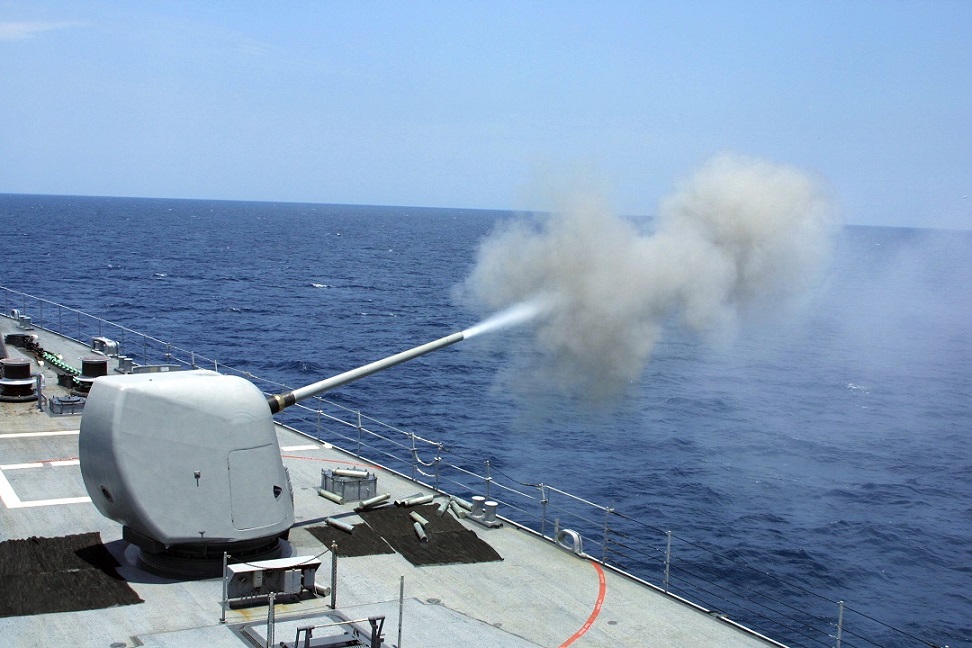In part 1, the developments on naval weapon systems till the 13th century were covered. In part 2, the developments in armament technology and the evolution of gunnery tactics between the fifteenth and the early twentieth century is covered.
Fifteenth and Sixteenth Century – Age of Sail
The Battle of Lepanto in 1571 was the last great naval action between fleets of oared warships and was the largest naval battle in Western history since classical antiquity, involving more than 400 warships (galleys and galleasses). In this battle, a combined Christian fleet of Spain, Venice, Malta, Genoa, and the Papal State defeated a similarly sized Turkish fleet. The Christian coalition had the numerical superiority in guns and cannons aboard their ships. It is estimated that the Christian coalition had 1,815 guns, while the Turks had only 750 with insufficient ammunition.
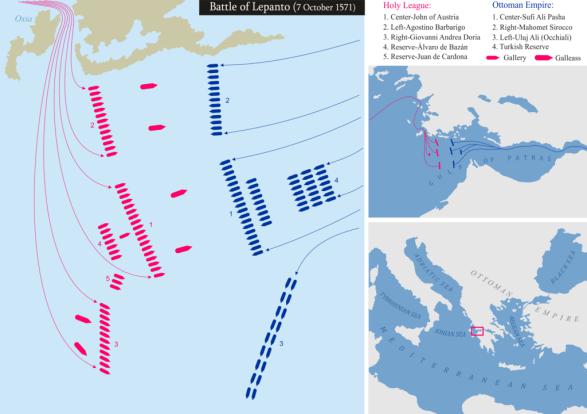
Over the following decades, the galleon became the major warship of its era over the galley, marking the beginning of the “Age of Sail”1. From the late Middle Ages onwards, warships began to be armed with cannon of various calibres as the primary weapon on-board warships2. The stoutly built sailing ships of England, Spain, Holland, France, and Portugal quickly adapted these new weapons onboard. The trends were typified in the English warship, Great Harry. Built-in 1514, the Great Harry carried 124 guns of which 43 were classified as heavy. Since these ships relied on sails and did not depend on rowers for propulsion, deck space was available. The problem of recoil of the cannon after firing was overcome by the use of a carriage, which rolled backwards across the deck absorbing the shock without damage to the ship. The backwards motion of the cannon also permitted access to the muzzle for reaming out residue after firing. Even with these improvements, the more powerful weapons were so heavy that they had to be placed near the waterline to maintain vessel stability.
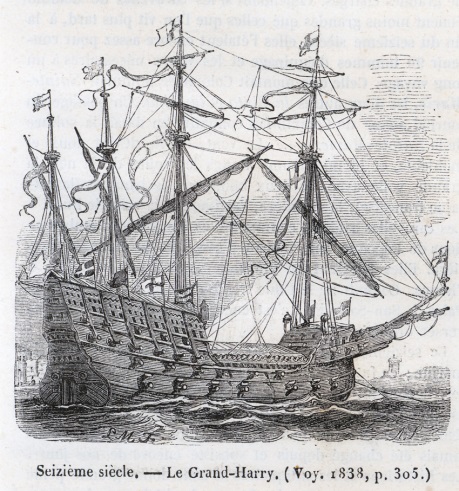
During the fifteenth century, most Mediterranean powers were utilising heavy cannon mounted on the bow or stern of a vessel and designed to bombard fortresses onshore. Subsequently, some vessels also carried smaller broadside cannons for bombarding other vessels immediately prior to an attempted boarding. Soon enough, more cannons were placed broadsides with gun ports cut in the hull of ships, to maximise fire.
It was during the fifteenth century that manufacture of cannon underwent a major change. The earlier technique of built-up bombards for gun barrels was abandoned in favour of the modern bellmakers’ techniques of casting the gun barrels. Over time it was found that guns cast in a single piece of bronze or brass were far more reliable than the built-up bombards. This innovation saw a rapid proliferation of guns of various sizes and shape, which presented a major logistical problem to naval commanders and rulers alike. Many countries restricted the number of types cannon, with Spain having no more than seven types of cannon3 and France cutting the number of calibres to six. However, the English used sixteen sizes ranging from a four-ton Cannon Royal, which fired a 68-74 pound shot. The effectiveness of gunpowder weapons was taking on major tactical significance for naval warfare as they already had for siege warfare in land battles. The culverin, firing an 18-pound shot4, was the long-range weapon of the period. It had a “point-blank” range of about 300 yards and a maximum range of 2600 yards.
The 16th century was an era of transition in naval warfare tactics; the introduction of guns slowly changed the dynamics of ship-to-ship combat. Improvements in gun manufacture had yielded a cannon that in shape and general appearance was the smoothbore, muzzleloader and would dominate naval tactics for the next four centuries. The combination of gunpowder, cannon, and the sailing ship took naval combat from ramming, boarding and hand-to-hand action at sword’s length, to pounds of cannon shot delivered at tens to hundreds of yards.
The naval cannon and stout sailing ship for all practical purposes continued to be the mainstay of navies and did not undergo any basic changes until the Industrial Revolution when they were eventually superseded with steam, steel, and turreted naval guns. The only significant changes during this period were the increase in the size of guns and warships as well as did the number of guns per vessel. The large sail ships like carrack and galleon were mounted with a great variety of different types and sizes of cannon as their main armament. A 17th-century ship of the line typically mounted5 32-pounder or 36-pounder long guns on a lower deck, and 18- or 24-pounders on an upper deck, with some 12-pounders on the forecastle and quarterdeck. “Pound” rating was commonly used to define guns. It was the weight of a single solid iron shot fired by that bore of cannon. Common sizes were 42-pounders, 36-pounders, 32-pounders, 24-pounders, 18-pounders, 12-pounders, 9-pounders, 8-pounders, 6-pounders, and various smaller calibres.
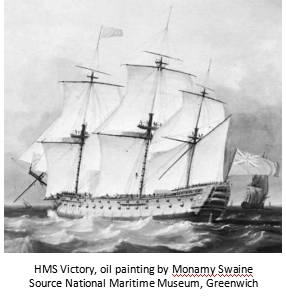
The fitment of the cannons on the sides of ships was a transformational change in ship design and ushered a fundamental change in naval tactics. The prevailing galley tactics6, suited for oared ships, had dominated naval warfare from antiquity until the 16th century. The cannon-armed sail ships with the ability to engage each other at ranges of tens of yards and without the need for hand to hand combat rendered galley tactics obsolete. By the 1650s, the line of battle7 had evolved as a naval tactic so as to take advantage of the broadside armament. Line of battle tactic formed the core of naval warfare during the Age of Sail, with navies adapting it to get the most broadside-on fire on to the enemy ships. However, sail and wood construction limited the role of the ship and greatly reduced the number and calibre of guns that could be placed upon them. Cannons were mounted on multiple decks on the Port and Starboard sides of the ship to maximise broadside effectiveness while engaging other ships. These cannons were also used for shore bombardment. During this period, ships engaged each other broadside fashion in a single line to bring all of their firepowers to bear on the enemy fleet, which was known as crossing the T or capping the T. It remained a classic naval warfare tactic used from the late 19th to mid-20th centuries, in which a line of warships manoeuvres to cross in front of a line of enemy ships, allowing the crossing line to bring all their guns to bear while receiving fire from only the forward guns of the enemy8. This tactic continued even after the advent of steam-powered battleships with rotating gun turrets, which were able to move faster and turn more quickly than sailing ships. The last recorded use of crossing the “T” was during the final phases of WW II ships during the Battle of Leyte Gulf in the Philippines. The tactic became largely obsolete with the introduction of missiles and aircraft. Ships and aircraft fitted with missiles could undertake long-range strikes, which are independent of the ship’s course.
Developments in the 17th and 18th Century – Application of Scientific Principles to Gunnery
Between the 17th and 18th centuries, new developments in naval weapons were hardly perceptible. Ships remained platforms for carrying infantry and, later, as basic gun platforms. Gunnery was still an art, not a science, and gunnery action was largely a matter of skilful seamanship in manoeuvring the ship into position to enable the gunners to hit the target. Gun engagements had hitherto relied on the practical experience of the gunners, luck or chance for hitting the target, as the range of engagement was insignificant. However, during this period scientific principles were first applied to gunnery. The earliest attempt to improve accuracy was by Niccolo Tartaglia, an Italian mathematician, who published two works on ballistics in 1537 and 1546 respectively, which were mainly obscure philosophical treatises and the range table values appear to have been derived rather arbitrarily.
It was in the middle of the 18th century that scientific principles were first applied to the art of gunnery. In 1742, British military engineer Benjamin Robins9 used Newtonian mechanics to calculate the projectile trajectory while taking into account the air resistance. He also carried out an extensive series of experiments in gunnery, embodying his results in his famous treatise on “New Principles in Gunnery”, which revolutionized the study of ballistics. His work had a substantive influence on the development of artillery during the latter half of the eighteenth century. Frederick the Great used it to advance Prussian artillery, especially to improve the accuracy of weapons. In 1745, Leonard Euler translated the book in German, adding his own extensive commentary. Euler’s annotated translation quickly became a standard text thereby influencing the education of artillery officers and, eventually, of all engineers.
Developments in the 19th and 20th Century – A period of Transformation
This was a period of intensive experimentation with new technology bringing a paradigm shift in naval gunnery due to improvements in metallurgy and machining techniques, the development of explosive shells and use of steam propulsion and steel plating for the hull. The last decade of the 19th century saw the introduction of steel construction for naval vessels, which made hulls stronger and therefore enabled them to be fitted with greater armament. The five decades between 1850 and 1900 was one of the most revolutionary periods in the history of naval warfare when transformational changes to guns, projectiles and gunpowder took place triggered by. This was the time that the technological advances in land artillery weapons — quick-firing, fixed ammunition, breech-loading, rifled guns — were seriously applied to naval guns.
The shift from muzzle loading to breech-loading was a revolutionary change in gun design, which marked the birth of modern artillery both on land and at sea. The new artillery gun (Armstrong Gun) developed William Armstrong10 for the Royal Navy had a rifled barrel, which allowed for a much more accurate and powerful action. The cast-iron shell was coated with lead, which made it fractionally larger than the gun’s bore and engaged with the gun’s rifling grooves to impart spin to the shell. This spin, together with the elimination of windage because of the tight fit, enabled the gun to achieve greater range and accuracy than existing smoothbore muzzle-loaders with a smaller powder charge. The advances in metallurgy, particularly improvements to steel, and precision engineering capabilities enabled the development of a breech-loading mechanism, which could withstand the explosive charge. The gun combined all the properties that make up an effective artillery piece. The gun was mounted on a carriage in such a way as to return the gun to firing position after the recoil. A final development in naval gunnery during the last quarter of the nineteenth century was the quick-firing gun, which improves the rate of fire of guns. A breech-loader was developed in 1881, which could fire at the rate of twelve aimed shots per minute was produced. At the time, the breech-loaders larger than 12-inch calibre were firing at the rate of one every two minutes. By placing the projectile and propellant in one cartridge, using a rapid working breech lock and a quick-return recoil device, high rates of fire were achieved in weapons up to 6-inch calibre. A converging development was the improvement in gunpowder, which permitted the lengthening of gun barrels to achieve higher muzzle velocities. The slower burning, smokeless chemical propellants made longer barrels an advantage by providing a propelling force over a longer period of time. Projectiles fired by the rapidly improving gun were themselves being transformed. The use of protective armour with hardened steel necessitated changes projectiles, which underwent a series of changes between 1878 and 1896. Hardness, construction and types of caps were varied to achieve the penetrating power necessary to puncture the hardened steel armour. In 1895 a “semi-armour piercing” shell was developed which carried a “five percent capacity bursting charge that exploded part of the way through the armoured plate.
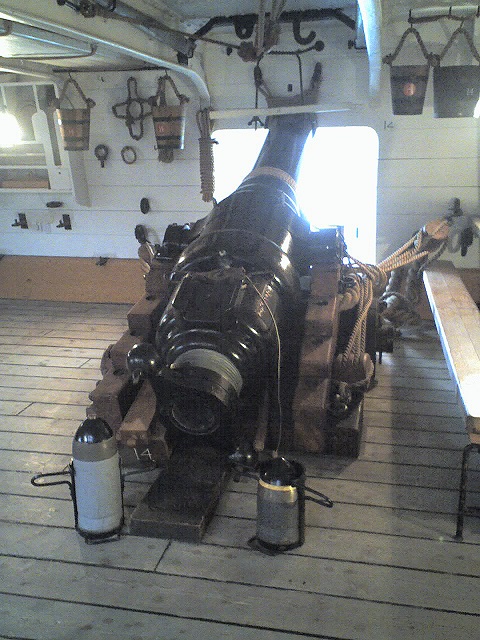
Breech-loading 110-pounder Armstrong gun on HMS Warrior
pic courtesy: https://commons.wikimedia.org/wiki
Another significant improvement to naval gunnery effectiveness was the continuous-aim gunfire system devised by Sir Percy Scott of the British Navy and improved by William S. Sims11 of the US Navy. The poor marksmanship of the naval ships was a well-known fact. During the Russo-Japanese War of 1904-1905, the first great fleet action of the twentieth century, thousands of rounds of all calibres were fired between the fleets and only a dozen hits were scored of which a mere four shots were decisive as they crippled the flag ships12. Scott perfected a way to allow gunners to keep their sights fixed on target despite the rolling of the ship. His aiming method ensured that HMS Terrible was the crack gunnery ship of the Royal Navy. A training aid known as a “dotter” was also devised and used on the British cruiser and enabled the gun crews to practice their continuous aim firing without expending any ammunition13. As late as 1898, prior to Scott’s changes, typical Royal Navy gunnery practice was held at 1,600 yards, the effective range for weapons, which could fire a projectile out to 20,000 yards. Within six years, the effective range of the Royal Navy’s ships had increased by a factor of ten.
Another significant design change in naval gunnery was the invention of the armoured turret by Captain Cowper Phipps Coles14 and the installation of these turrets on HMS Prince Albert & HMS Royal Sovereign. However, it was not simple to convince the Admiralty and required enlisting public support, including Prince Albert, who wrote to the First Lord of the Admiralty, the Duke of Somerset, supporting the construction of a turret ship. In January 1862, the Admiralty agreed to construct a ship, HMS Prince Albert, which had four turrets and a low freeboard, intended only for coastal defence.
Gradually ships began to mount multiple turrets, first with one gun per turret and, finally, by 1900, four guns per turret was the standard fit. With improvements in metallurgy, the calibre of guns progressively became larger. The calibre increased from 12-inch guns (1908) to 15-inch guns as standard by 1914. By 1913, naval ships were powered by oil instead of coal boilers, greatly increasing propulsive power while freeing up space for fitment of additional gun mounts.
Title image courtesy: https://kalingatv.com/world/
Disclaimer: The views and opinions expressed by the author do not necessarily reflect the views of the Government of India and Defence Research and Studies
References:
- The Age of Sail (usually dated as 1571–1862) was a period roughly corresponding to the early modern period in which international trade and naval warfare were dominated by sailing ships and gunpowder warfare, lasting from the mid-16th to the mid-19th centuries.
- https://en.wikipedia.org/wiki/Naval_artillery
- Cleator, P. E. , Weapons of War , Thomas Y. Crowell Co., 1967, p 128
- Macintyre, D. and Bathe, B. W., Man-of-War: A History of the Combat Vessel, McGraw Hill Book Co., 1968. P 38
- A ship of the line was a type of naval warship constructed from the 17th through to the mid-19th century to take part in the naval tactic known as the line of battle, in which two columns of opposing warships would manoeuvre to bring the greatest weight of broadside firepower to bear. Since these engagements were almost invariably won by the heaviest ships carrying the most powerful guns, the natural progression was to build sailing vessels that were the largest and most powerful of their time.
- Galley tactics as practised from antiquity to the Middle Ages until the 16th century essentially was to use the ship itself as the weapon. All galley actions were fought at close quarters, where ramming and boarding were possible. The ship had a heavy bronze ram to sink the opponent. Missile weapons such as bolts from heavy crossbows fixed on the bulwarks, bows and arrows, weights dropped from a yard or pole rigged out, and the various means of setting an enemy alight were also employed. This was invariably followed by boarding and was the only means of deciding a naval engagement.
- In naval warfare, the line of battle is a tactic in which a naval fleet of ships forms a line end to end. Its first use is disputed, variously claimed for dates ranging from 1502 to 1652, with line-of-battle tactics in widespread use by 1675.
- Hughes, Wayne P. (2000). Fleet tactics and coastal combat. Naval Institute Press. p. 74.
- Benjamin Robins was born in Bath to poor Quakers parents and received very little formal education but devoted himself to engineering and the study of fortification. In 1749, he was appointed Engineer General to the East India Company, and went out to superintend the reconstruction of their forts. He died at Fort St David, Cuddalore in India.
- William George Armstrong, 1st Baron Armstrong was an English industrialist who founded the Armstrong Whitworth manufacturing concern on Tyneside. He was also an eminent scientist, inventor and philanthropist. He is regarded as the inventor of modern artillery
- William Sowden Sims retired as an Admiral in the United States Navy. As a Lt he sought to reform naval gunnery by improving target practice. When his suggestions were resisted by the navy, he wrote directly to the President (Theodore Roosevelt) who made him the Navy’s Inspector of Naval Gunnery. During World War I he commanded all United States naval forces operating in Europe. He also served twice as president of the Naval War College.
- Hattendorf, J., “Technology and Strategy” in War, Strategy, and Maritime Power, Simpson, B. M. Ed., Rutgers University, 1977
- Miller, N. , The U.S. Navy; An Illustrated History, American Heritage and U.S. Naval Institute Press, 1979. P 244
- Captain Cowper Phipps Coles, C.B., R.N. (1819 – 1870), was an English naval captain and inventor and was the first to patent a design for a revolving gun turret. Coles died in a maritime accident in 1870 when HMS Captain, an experimental warship built to his designs, capsized and sank with him on board.

